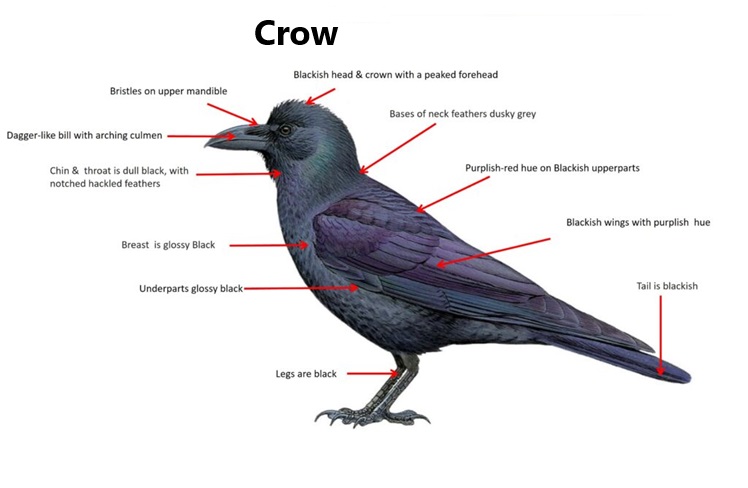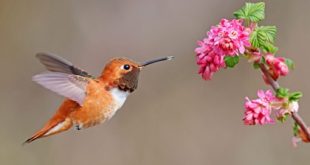The crow, a common and highly intelligent bird, belongs to the Corvidae family and is found worldwide in various environments, ranging from urban areas to forests. While often overlooked due to its ubiquity, the crow’s body is a fascinating example of evolutionary adaptation. Each part of its anatomy is uniquely designed to help it survive and thrive in diverse habitats. This article explores the body parts of a crow and their functions, shedding light on what makes this bird so remarkable.
A Body Parts Of Crow

1. Head
The crow’s head houses its brain, eyes, beak, and other critical sensory organs.
- Brain: Crows are known for their extraordinary intelligence. Their brain-to-body size ratio rivals that of some primates. They can solve complex problems, recognize faces, and even use tools. This advanced cognitive ability allows them to adapt to different environments and exploit various food sources.
- Eyes: Crows have excellent vision. Their eyes are located on the sides of their head, giving them a broad field of view to spot predators and locate food. They can see ultraviolet light, enabling them to detect details invisible to the human eye.
- Beak: The crow’s beak is sturdy, sharp, and versatile. It’s used for a range of tasks, including cracking open nuts, tearing flesh, probing the ground for insects, and even crafting tools. The beak also plays a role in communication, as crows often tap or click their beaks during social interactions.
2. Neck
The crow’s neck is flexible and muscular, allowing it to move its head in various directions. This adaptability aids in precise foraging, grooming, and keeping an eye on potential threats. The neck also supports the bird’s vocal cords, which enable their wide range of calls and mimicry abilities.
3. Wings
A crow’s wings are broad and powerful, adapted for both short bursts of speed and sustained flight.
- Primary Feathers: These are the long feathers on the tips of the wings, crucial for propulsion during flight.
- Secondary Feathers: Found closer to the body, these feathers help in lifting and maneuvering.
- Wing Structure: The skeletal and muscular structure of the wings allows for efficient flight, enabling crows to travel long distances and perform acrobatic maneuvers.
4. Chest (Thorax)
The thorax houses vital organs such as the heart and lungs. Crows have a high metabolic rate to support their active lifestyle, and their powerful lungs ensure efficient oxygen exchange, even during flight. The muscles attached to the thorax, particularly the pectoral muscles, power the wings and are essential for sustained flight.
5. Back and Spine
The crow’s back and spine provide structural support and balance. The spine is highly flexible, aiding in movement and agility. The back also supports the wings and tail, ensuring stability during flight and while perched.
6. Tail
The crow’s tail consists of stiff feathers arranged in a fan shape. It plays a crucial role in flight, helping with steering, braking, and maintaining balance. The tail also aids in communication, as crows sometimes use tail movements as part of their social signals.
7. Legs and Feet
Crows have strong, versatile legs and feet adapted for perching, walking, and manipulating objects.
- Toes: They have three forward-facing toes and one backward-facing toe, all equipped with sharp claws. This configuration allows them to grip branches firmly and handle food effectively.
- Leg Muscles: The muscular legs enable crows to walk, hop, and even run short distances. They’re also capable of gripping and tearing apart prey.
8. Feathers
The crow’s feathers serve multiple purposes beyond flight.
- Insulation: Feathers provide insulation, helping crows regulate their body temperature in different climates.
- Camouflage: Their black coloration helps them blend into shadows, offering protection from predators. It also plays a role in social interactions, as the sheen of their feathers can indicate health and vitality.
- Waterproofing: The feathers are coated with natural oils, making them waterproof and ensuring they remain functional even in wet conditions.
9. Beak and Tongue
The crow’s beak is not only strong but also sensitive, allowing it to manipulate objects with precision. Their tongue complements this functionality by helping to hold and position food. Together, these features make the crow highly effective at foraging and tool use.
10. Internal Organs
- Digestive System: Crows have a specialized digestive system capable of processing a wide variety of foods, from seeds and fruits to meat and human scraps. Their crop, a pouch in the esophagus, allows them to store food temporarily before digestion.
- Respiratory System: Their lungs are highly efficient, supported by air sacs that ensure a continuous flow of oxygen. This is especially crucial during flight.
- Circulatory System: The crow’s heart is strong and pumps oxygen-rich blood efficiently to meet the demands of its active lifestyle.
11. Vocal Apparatus
Crows have a syrinx, a specialized vocal organ located at the base of their trachea. This organ enables them to produce a wide variety of sounds, from caws and clicks to complex vocalizations. Their ability to mimic human speech and other sounds is a testament to the complexity of their vocal apparatus.
12. Skin and Beak Keratin
The skin and the outer layer of the beak are made of keratin, a durable protein. This provides protection against wear and tear while enabling the beak to remain sharp and functional.
13. Sense Organs
- Hearing: Crows have acute hearing, allowing them to detect subtle sounds, including the calls of other crows.
- Smell: While their sense of smell is not as developed as their vision or hearing, it’s sufficient to help them locate food in some cases.
- Touch: The beak’s tip is highly sensitive, enabling precise manipulation of objects.
Adaptations for Survival
Crows have evolved several adaptations that make them one of the most successful bird species on Earth:
- Versatile Diet: Their omnivorous diet allows them to thrive in diverse environments.
- Social Behavior: Crows live in groups and exhibit cooperative behaviors, such as sharing food and mobbing predators.
- Problem-Solving Skills: Their intelligence enables them to adapt to human-altered landscapes and exploit new resources.
- Flight Efficiency: Their powerful wings and efficient respiratory system support long-distance travel and agility in flight.
Conclusion
The crow’s anatomy is a masterpiece of evolution, with each body part playing a crucial role in its survival and success. From its sharp beak and keen eyes to its powerful wings and intelligent brain, the crow is a marvel of adaptability. Understanding the body parts of a crow and their functions not only highlights the bird’s remarkable abilities but also underscores the intricate relationship between anatomy and behavior in the animal kingdom. Whether admired for their intelligence or observed in their natural habitat, crows continue to captivate and inspire us with their extraordinary capabilities.


